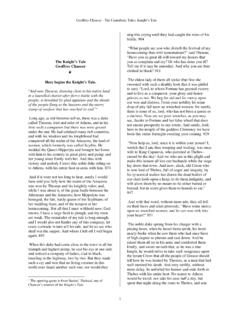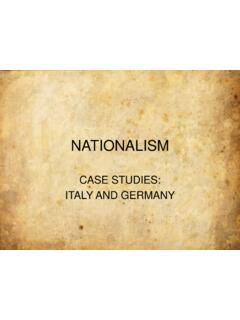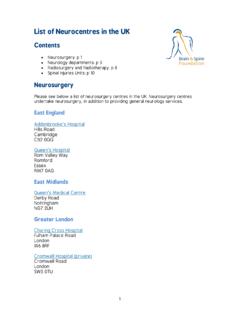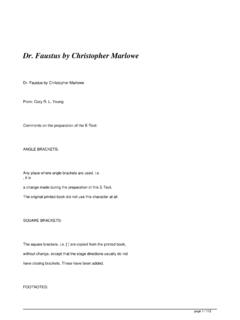Transcription of Basics of English Studies: An introductory course for ...
1 STEFANIE LETHBRIDGE AND JARMILA MILDORF: Basics of English studies : an introductory course for students of literary studies in English . Developed at the English departments of the Universities of T bingen, Stuttgart and Freiburg 4. Poetry Table of Contents: What Is Poetry? .. 142. Outward Indications .. 142. Types of Poetry .. 144. Lyric Poetry .. 144. Narrative Poetry .. 145. Descriptive and Didactic Poetry .. 146. Prosodic Features: Metre and Rhythm .. 146. Metre .. 146. Accentual Metre .. 147. Syllabic Metre .. 148. Accentual-Syllabic Metre .. 149. SO WHAT? .. 151. Free Verse .. 152. Maximisation Principle and Metrical Grid .. 152. Metrical Deviation .. 153. Substitutions .. 153. Recitation .. 154. SO WHAT?
2 154. Rhythm .. 156. Pauses at the End of Lines .. 156. SO WHAT? .. 158. Pauses within Lines .. 158. Elisions and Expansions .. 158. Vowel Length and Consonant Clusters .. 159. Modulation .. 161. Prosodic Features: Sound Patterns .. 162. Rhyme .. 162. Alliteration, Assonance, Onomatopoeia .. 164. SO WHAT? .. 164. Verse Forms and Stanza Forms .. 165. SO WHAT? .. 172. Form and Meaning in Poetry .. 173. Bibliography: Poetry .. 175. Basics of English studies , Version 12/03, Poetry 141. 4. Poetry What is Poetry? Key terms: overstructuring communication model To ask What is poetry?' is very much like asking What is literature?' and in fact the answers to both these questions overlap: Poetry is perceived as fictional, it uses specialised language, in many cases it lacks a pragmatic function, it is also ambiguous (see Basic Concepts ch.)
3 Outward Indications In addition, there are a number of outward signs that indicate a poem: Most obviously, the individual text lines in poetry do not fill the entire width of the page. Thus, before they have actually started reading, readers of poetry are given an instant indication that what they are going to read is probably a poem. In consequence, a reader's attention is likely to focus on poetic features' of the text. Poetry is often associated not only with specialised language but with a very dense use of such specialised language. Poems usually try to express their meaning in much less space than, say, a novel or even a short story. Alexander Pope once explained that he preferred to write poetry even when he wrote about philosophy because it enabled him to express himself more briefly (Pope, Preface to An Essay on Man, 1734).
4 As a result of its relative brevity, poetry tends to make more concentrated use of formal elements, it displays a tendency for structural, phonological, morphological and syntactic overstructuring, a concept which originated in formalist and structuralist criticism. It means that poetry uses elements such as sound patterns, verse and metre, rhetorical devices, style, stanza form or imagery more frequently than other types of text. Obviously, not all poems use all these elements and not all verse is poetry, as John Hollander remarks (Hollander 2001: 1). Especially modern poets deliberately flaunt reader expectations about poetic language (see the found poem' in ch. ). Nonetheless, most poetry depends on the aesthetic effects of a formalised use of language.
5 Some people associate poetry with subjectivity and the expression of intense personal experience. While this is true for some poetry, especially lyrical poetry, there are a great number of poems this does not apply to; for example narrative poems like Scott's Marmion or didactic and philosophical poems like Pope's Essay on Man or John Philips' Cyder. Just as it is often misleading to identify the author of a novel with its narrator, one should not assume that the author of a poem is identical with its speaker and thus even lyrical poems cannot be treated as subjective expressions of the author. The two levels of author and speaker should always be kept separate. The communication situation in poetry is very similar to the one in prose, except that poetry very often does not include dialogue, thus the inner box is optional: Basics of English studies , Version 12/03, Poetry 142.
6 POEM. author speaker (character (character addressee actual who speaks) who listens) (optional) reader Code/Message Searching for a definition of poetry, other readers look for universal truth' or some other deeper meaning in poetry more than in prose, the famous nineteenth-century critic Matthew Arnold for instance (see Arnold 1880). Again, while some poetry might very well deal with universal truths, this is probably not the case for all. There is no doubt some poetry which is very lovely and very popular but which, at bottom, is really neither very profound nor the expression of a universal truth. Take these lines by Ben Jonson for instance, one of the most popular love songs in the last 400 years: To Celia Drink to me only with thine eyes And I will pledge with mine.
7 Or leave a kiss but in the cup, And I'll not look for wine. The thirst that from the soul doth rise, Doth ask a drink divine: But might I of Jove's nectar sup, I would not change for thine. [..]. In fact, to expect statements of universal truth from poetry can be rather misleading if one deduces from this that what matters in a poem is somehow what lies behind the language and its use (for this problem see the discussion in Warren/Brooks 1960: 6-20), whereas modern criticism insists that form cannot be separated from meaning (See also Theme ch. ). It is difficult to answer the question What is Poetry?' conclusively, though most people are more or less able to recognise poetry when they see it. One recent critic has suggested the following criteria in answer to the question What is Poetry?
8 ' (M ller-Zettelmann 2000: 73-156): Basics of English studies , Version 12/03, Poetry 143. Poetic texts have a tendency to relative brevity (with some notable exceptions). dense expression express subjectivity more than other texts display a musical or songlike quality be structurally and phonologically overstructured be syntactically and morphologically overstructured deviate from everyday language aesthetic self-referentiality (which means that they draw attention to themselves as art form both through the form in which they are written and through explicit references to the writing of poetry). With all the difficulties of defining poetry it is worth remembering that poetry, especially in the form of song, is one of the oldest forms of artistic expression, much older than prose, and that it seems to answer or to originate in a human impulse that reaches for expression in joy, grief, doubt, hope, loneliness, and much more.
9 Types of Poetry Key terms: When studying poetry, it is useful first of all to consider the theme and the lyric poetry overall development of the theme in the poem (see ch. ). Obviously, the elegy sort of development that takes place depends to a considerable extent on the ode type of poem one is dealing with. It is useful to keep two general distinctions in sonnet mind (for more detailed definitions consult Abrams 1999 and Preminger et al dramatic monologue 1993): lyric poetry and narrative poetry. occasional poetry epithalamion narrative poetry epic Lyric Poetry mock-epic ballad descriptive poetry A lyric poem is a comparatively short, non-narrative poem in which a single dramatic poetry speaker presents a state of mind or an emotional state.
10 Lyric poetry retains didactic poetry some of the elements of song which is said to be its origin: For Greek writers prodesse et delectare the lyric was a song accompanied by the lyre. Subcategories of the lyric are, for example elegy, ode, sonnet and dramatic monologue and most occasional poetry: In modern usage, elegy is a formal lament for the death of a particular person (for example Tennyson's In Memoriam ). More broadly defined, the term elegy is also used for solemn meditations often on questions of death, such as Gray's Elegy Written in a Country Churchyard. An ode is a long lyric poem with a serious subject written in an elevated style. Famous examples are Wordsworth's Hymn to Duty or Keats' Ode to a Grecian Urn.





